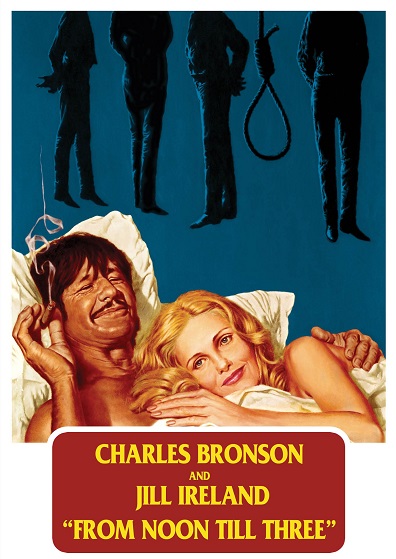
From Noon Till Three
Studio: Kino Lorber Studio Classics
Jun 19, 2017
Web Exclusive
![]()
By the mid-Seventies, the Western genre was in decline, and while the action/adventure genre would soon become predominant, Westerns simply became passé. Yet that didn’t mean Hollywood had given up entirely on the genre, and 1976’s From Noon Till Three is a rare, unique entry into the annals of Western movies, a dark film that’s part comedy, part drama, and one that contains one of Hollywood’s more interesting commentaries on the nature of celebrity and myth-making.
From Noon Till Three served as a vehicle for leading man Charles Bronson and his wife, Jill Ireland. Bronson plays Graham Dorsey, the leader of a rag-tag gang of bank robbers and criminals. On the eve of a major bank robbery, Dorsey has a nightmare about it, one that shows his gang being slaughtered in a shootout. When one of the horses gives way, the gang happens upon the isolated mansion of Amanda Starbuck, a widow. Starbuck insists there is no horse, and when they hear a noise in the barn, Dorsey goes to investigate her claim that it is a cow they have heard. He sees that she is lying, but sensing a way to get out of the afternoon’s escapade, he confirms her story. The gang rides off without Dorsey, stating that they would return from their robbery at three o’clock.
With the gang gone, Dorsey starts to learn about Starbuck’s story, and though she is initially resistant to his charms and romantic overtures, she eventually consents; it’s the first romance she’s had since her husband’s death, and the two spend a passionate afternoon together. As three o’clock approaches, they are saddened that their interlude must come to an end. But when a young boy rides up to tell Starbuck that there had been a robbery that was foiled, in which one of the robbers was killed and the others to be hung, Dorsey is jubilant; he can stay with her and they can continue their romance. Surprisingly, this shocks Starbuck; she insists that to abandon his friends in their time of need is cowardly, and encourages him to go and at least attempt to help out. Learning that there was another man in the group, a posse is formed, and Dorsey soon discovers he’s a wanted man. He soon happens upon a quack dentist whom he robs of his clothes and wagon, and when the posse finds the dentist, he is killed, believed to have been Dorsey. Starbuck, who rides into town to witness the hanging, is there when the dentist’s body is brought in. She sees the man wearing Dorsey’s clothes—which were, in fact, her late husband’s suit that Dorsey had forgotten to change out of when he rode off—and faints, thinking her lover has died.
When she comes to, she confesses why she was so distraught, and of her love for this stranger. Though initially she is treated as scandalous, the townsfolk realize that she was a lonely woman who had found love again, and they soon apologize to her. In the townsfolk who ride to her mansion is a traveling writer and reporter, who is so touched by the story, he offers to tell her tale. Dorsey, happy in his newfound role of seeming to be a medicine man, soon discovers that the dentist is a wanted man, and winds up in prison for fraud. While in prison, Starbuck’s life story becomes an internationally beloved tale of doomed love, passion, and romance, with Dorsey soon becoming a household name. He learns of this while in prison and when he is released, he sets about on a return to Starbuck and to pick up on the romance of a lifetime.
What happens next in this delightful little film is both shocking and heartbreaking, and ultimately a none-too-subtle commentary on the nature of celebrity, legend, and myth. It’s a surprise twist; indeed, this reviewer didn’t see it coming, and what was a poignant comedy takes a dark turn. Yet forty years on and in a celebrity-obsessed popular culture, From Noon Till Three’s moral is surprisingly quite relevant. That the movie is beautifully filmed by Lucien Ballard and wonderfully scored by Elmer Bernstein only adds to its appeal—its love song, “Hello And Goodbye,” was sung by Ireland; it was a modest hit, and earned the film a Golden Globe nomination. Though obscure by today’s standards—it’s not one of Bronson’s more notable roles—From Noon Till Three is an obscure delight that surprisingly still has an important message to convey.
www.kinolorber.com/product/view/id/4129
Current Issue

Issue #72
Apr 19, 2024 Issue #72 - The ‘90s Issue with The Cardigans and Thurston Moore
Most Recent
- Under the Radar Announces The ’90s Issue with The Cardigans and Thurston Moore on the Covers (News) — The Cardigans, Thurston Moore, Sonic Youth, Garbage, The Cranberries, Pavement, Lisa Loeb, Supergrass, Spiritualized, Lush, Miki Berenyi, Miki Berenyi Trio, Emma Anderson, Hatchie, Ride, Slowdive, Velocity Girl, Penelope Spheeris, Terry Gilliam, Gus Van Sant, Ron Underwood, Kula Shaker, Salad, Foals, Semisonic, The Boo Radleys, Stereo MC’s, Pale Saints, Blonde Redhead, Sleater-Kinney, Cocteau Twins, Lucy Dacus, Alex Lahey, Horsegirl, Grandaddy, alt-J, Squid, The Natvral, Wolf Alice, Jess Williamson, Sunflower Bean, Orville Peck, Joel McHale
- Challengers (Review) —
- Premiere: Eric Schroeder Shares New Track “The Kind of Wound That Never Heals” (News) — Eric Schroeder
- Thurston Moore Shares New Song “Rewilding” (News) — Thurston Moore, Sonic Youth
- Thom Yorke Confirms “Confidenza” Soundtrack, Shares New Songs “Knife Edge” and “Prize Giving” (News) — Thom Yorke, Radiohead, The Smile

Comments
Submit your comment
November 28th 2017
9:03pm
A great movies, which brings back fond memories of my mother and father going to the drivings in the late 70’s, with my 2 brothers in our 1975 mazda